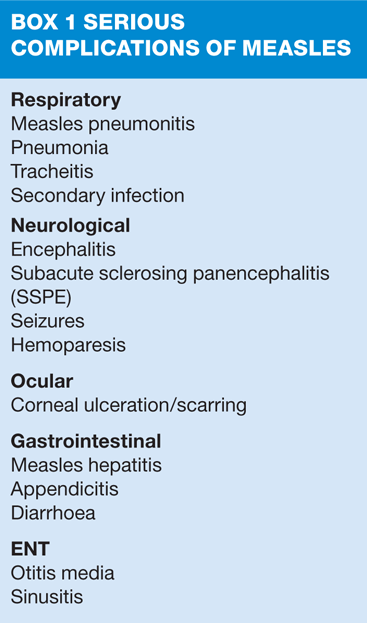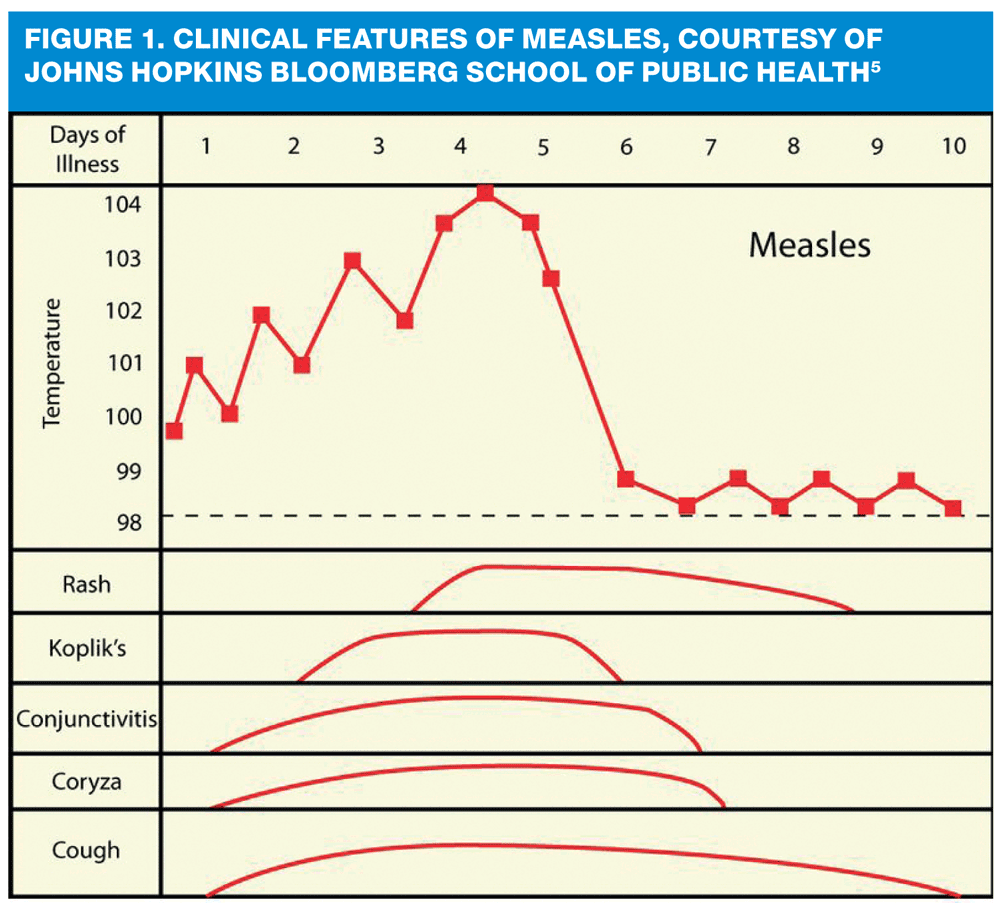Infectious diseases in children: Measles
Dr Mary Lowth
Dr Mary Lowth
MA MB BChir FRCGP PGCME
GP and medical educationalist
The current measles outbreaks in Wales, the North East and now London, saw a further surge in reported cases over Easter, with a 25% increase in new cases, bringing the total to more than 620 as Practice Nurse went to press, of which 109 new cases were reported in a single week. But the good news is that there has also been a significant increase in the number of people requesting MMR vaccination for their children
Measles was universally experienced in childhood by most adults who are over the age of 50 today. Since widespread vaccination it has become much less common. Most practice nurses will have seen measles seldom or never (the incidence is currently around 1,000 cases a year in the UK,1) but we need to remain aware of its presentation and alert to its symptoms — particularly in light of the current outbreak in Wales. Low vaccine uptake combined with the fact that measles is endemic (see below) mean that children anywhere in the UK could be at risk.
This matters because measles has a significant rate of complications (see Box 1) and it kills hundreds of children worldwide every day.2 It is a notifiable disease as there is significant public health interest in being aware of outbreaks and limiting their spread.
ORIGIN OF MEASLES
The measles virus evolved from the bovine rinderpest virus (a devastating cattle disease which is now eradicated) somewhere around a thousand years ago. Over time, natural resistance began to develop. However, the effect of measles on totally measles-naïve populations can be devastating: in the 1850s, measles wiped out a fifth of the population of Hawaii and killed more than 40,000 Fijians — one-third of the population. Measles has also ravaged the native populations of Cuba, Mexico, Central America and the Inca civilization.
SPREAD OF MEASLES
Measles spreads mainly by respiratory droplet infection — convenient for the disease, as it causes a cough. Measles is an endemic disease in most populations, which means it is constantly present in the population and can spread there without need for external inputs.
Due to continuing low mumps-measles-rubella (MMR) vaccination coverage, the number of children in the UK susceptible to measles is now sufficient to support the continuous spread of measles in the event of an outbreak.
SYMPTOMS: THE THREE Cs
Children with measles feel grotty. They tend to look miserable — the three C's are cough, coryza and conjunctivitis: they have a sore throat, their eyes are sore, they tend to feel generally unwell.
Cough
The first symptom is a cough, which peaks at three days and then lasts a further week. It's often a dry, sore cough and tracheitis or pneumonia as a secondary infection can result.
Pyrexia
Temperature tends to start to rise the day the cough appears and peaks at day, 5 settling around the end of the first week.
Conjunctivitis and coryza
Sore red eyes and a runny nose tend to develop early, with the cough, although they tend to settle down well before the cough.
Rash
The rash does not appear until around day three.
The measles rash is classically called a mobilliform (measles-like!) rash. It's a maculopapular rash that starts behind the ears and spreads down to the whole of the body. It starts off spotty but eventually becomes blotchy and confluent. It tends to start desquamating in the second week.
Kopliks spots
Kopliks spots are famous, but hardly anyone in the UK has ever seen them. They are white spots on the buccal mucosa, present from about 24 hours into the infection, and lasting for a few days. They are said to be pathognomonic of measles but are very difficult to see.
INFECTIOUSNESS
Measles has an incubation period of around two weeks and is infectious from a couple of days before the rash appears until about a week after it appears. Children are usually kept off school or nursery till the rash has gone.
DIAGNOSIS
Diagnosis requires the presence of a three-day fever (at least) together with cough, coryza or conjunctivitis and positive serology for new measles antibodies (IgM). Contact with an infected person adds weight to the evidence, and infection can occur through saliva, semen or mucus in addition to the usual respiratory droplet infection.
COMPLICATIONS
The serious complications of measles can occur in previously healthy children. Unvaccinated children who are older are more vulnerable.
The two most serious complications are encephalitis and subacute sclerosing panencephalitis (SSPE).
Encephalitis occurs in approximately 1 in 5,000 UK cases, usually a week into the illness. It has a 15% mortality rate, and a further 40% develop serious long term complications including epilepsy, deafness, learning difficulties and hemiplegia.
SSPE is seen in only about 1 in 100,000 cases, seven years or so post-infection. It is a gradual but devastating neurological illness that causes loss of neurological function, leading to dementia and eventual death. Since measles immunisation was introduced it has become very rare.3
Pneumonitis is a particular risk in immuno-compromised individuals, particularly those with cancer.
In developing countries vitamin A deficient children can have a more severe and prolonged course of illness, and the rash may turn purple, desquamate and lead to depigmentation for many months.
MEASLES AND CROHN'S DISEASE
A few years ago there was widespread concern that there might be a link between measles or measles vaccine with Crohn's disease: it was suggested that measles virus had been found in the gut wall lesions of those with active Crohn's. However, the conclusions of the researchers were controversial and research and review over time have not shown a link.
TREATMENT
There is no specific treatment for measles although antiviral drugs are given to immunocompromised children: otherwise treatment is symptomatic. Children are nursed in isolation to avoid spread.
PREVENTION
Vaccine
Measles vaccine was developed in 1963. It is a live attenuated vaccine, and it was originally given alone but is now given in combination with mumps and rubella vaccines in the MMR.
Vaccination is not compulsory in Europe. As a result parental choices, made on religious or ethical grounds and through anxieties about side effects have meant that vaccine coverage is not sufficient to prevent outbreaks from occurring.
Worldwide, a huge vaccination initiative by WHO, UNICEF and others resulted in a 71% drop in measles deaths between 2000 and 2011 worldwide. In 2011, about 84% of the world's children received one dose of measles vaccine by their first birthday.
In developed countries measles is generally given as the two doses of MMR, one at 12-18 months (under 18 months children usually retain maternal measles antibodies from pregnancy), and the other preschool to try to eliminate the cohort who were not caught the first time or who did not develop sufficient immunity first time.
In developing countries two doses are given at 6 and 9 months. This includes children who are HIV positive, in whom it is less effective but not ineffective.
MMR AND AUTISM
The claims made in 1998 by Andrew Wakefield that there was a connection between MMR and autism have been very thoroughly discredited and were discussed in full in our previous article on mumps.4 The paper was retracted by the Lancet and the research declared fraudulent by the BMJ.
The publicity around the initial study caused vaccination rates to plunge in the UK, and case numbers increased almost at once.
SUMMARY
Measles presents rarely to the practice nurse, but given the susceptibility of many children to it and its tendency to occur in outbreaks, it is hugely important for the practice nurse to be aware of the significance of cough, coryza, conjunctivitis and a rash and to consider testing and notification if these are seen.
REFERENCES
1. Health Protection Agency Website: statistics on confirmed cases of measles, mumps and rubella (1996 — 2012) http://www.hpa.org.uk/web/HPAweb&HPAwebStandard/HPAweb_C/1195733833790 accessed February 13
2. WHO fact sheet on measles www.who.int/entity/mediacentre/factsheets/fs286/en/ accessed 21/2/13 WHO.int "” 'Initiative for Vaccine Research (IVR): Measles', World Health Organization (WHO)
3. Lissauer T and Clayden G, Third Illustrated Textbook of Paediatrics Mosby Elsevier 2007
4. Lowth M. Infectious diseases in children: Mumps. Practice Nurse February 2013;43(02):12-14
5. Clinical Features of Measles, from Epidemiology of Infectious Diseases. Available at: http://ocw.jhsph.edu. Copyright © Johns Hopkins Bloomberg School of Public Health. Creative Commons BY-NC-SA. Adapted by CTLT from Krugman, S., Katz, S. L., Gershon, A. A., and Wilfert, C. M. (Eds.). (1992). Infectious diseases of children (9th ed.) St. Louis: Mosby.
Related articles
View all Articles

